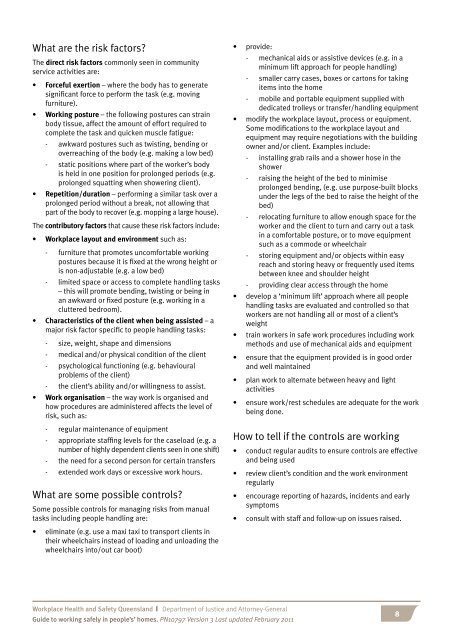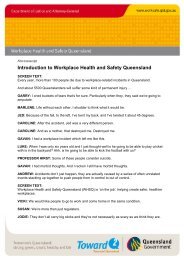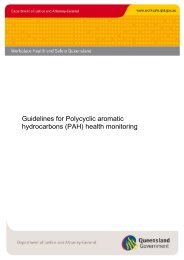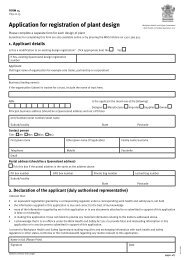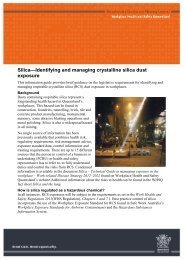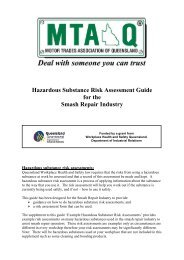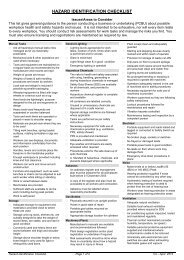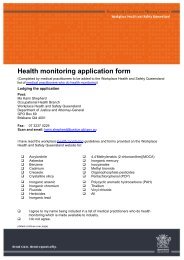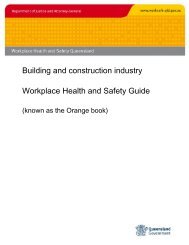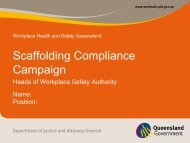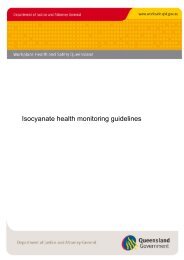Guide to working safely in people's homes - Queensland Government
Guide to working safely in people's homes - Queensland Government
Guide to working safely in people's homes - Queensland Government
You also want an ePaper? Increase the reach of your titles
YUMPU automatically turns print PDFs into web optimized ePapers that Google loves.
What are the risk fac<strong>to</strong>rs?<br />
The direct risk fac<strong>to</strong>rs commonly seen <strong>in</strong> community<br />
service activities are:<br />
• Forceful exertion – where the body has <strong>to</strong> generate<br />
significant force <strong>to</strong> perform the task (e.g. mov<strong>in</strong>g<br />
furniture).<br />
• Work<strong>in</strong>g posture – the follow<strong>in</strong>g postures can stra<strong>in</strong><br />
body tissue, affect the amount of effort required <strong>to</strong><br />
complete the task and quicken muscle fatigue:<br />
- awkward postures such as twist<strong>in</strong>g, bend<strong>in</strong>g or<br />
overreach<strong>in</strong>g of the body (e.g. mak<strong>in</strong>g a low bed)<br />
- static positions where part of the worker’s body<br />
is held <strong>in</strong> one position for prolonged periods (e.g.<br />
prolonged squatt<strong>in</strong>g when shower<strong>in</strong>g client).<br />
• Repetition/duration – perform<strong>in</strong>g a similar task over a<br />
prolonged period without a break, not allow<strong>in</strong>g that<br />
part of the body <strong>to</strong> recover (e.g. mopp<strong>in</strong>g a large house).<br />
The contribu<strong>to</strong>ry fac<strong>to</strong>rs that cause these risk fac<strong>to</strong>rs <strong>in</strong>clude:<br />
• Workplace layout and environment such as:<br />
- furniture that promotes uncomfortable <strong>work<strong>in</strong>g</strong><br />
postures because it is fixed at the wrong height or<br />
is non-adjustable (e.g. a low bed)<br />
- limited space or access <strong>to</strong> complete handl<strong>in</strong>g tasks<br />
– this will promote bend<strong>in</strong>g, twist<strong>in</strong>g or be<strong>in</strong>g <strong>in</strong><br />
an awkward or fixed posture (e.g. <strong>work<strong>in</strong>g</strong> <strong>in</strong> a<br />
cluttered bedroom).<br />
• Characteristics of the client when be<strong>in</strong>g assisted – a<br />
major risk fac<strong>to</strong>r specific <strong>to</strong> people handl<strong>in</strong>g tasks:<br />
- size, weight, shape and dimensions<br />
- medical and/or physical condition of the client<br />
- psychological function<strong>in</strong>g (e.g. behavioural<br />
problems of the client)<br />
- the client’s ability and/or will<strong>in</strong>gness <strong>to</strong> assist.<br />
• Work organisation – the way work is organised and<br />
how procedures are adm<strong>in</strong>istered affects the level of<br />
risk, such as:<br />
- regular ma<strong>in</strong>tenance of equipment<br />
- appropriate staff<strong>in</strong>g levels for the caseload (e.g. a<br />
number of highly dependent clients seen <strong>in</strong> one shift)<br />
- the need for a second person for certa<strong>in</strong> transfers<br />
- extended work days or excessive work hours.<br />
What are some possible controls?<br />
Some possible controls for manag<strong>in</strong>g risks from manual<br />
tasks <strong>in</strong>clud<strong>in</strong>g people handl<strong>in</strong>g are:<br />
• elim<strong>in</strong>ate (e.g. use a maxi taxi <strong>to</strong> transport clients <strong>in</strong><br />
their wheelchairs <strong>in</strong>stead of load<strong>in</strong>g and unload<strong>in</strong>g the<br />
wheelchairs <strong>in</strong><strong>to</strong>/out car boot)<br />
Workplace Health and Safety <strong>Queensland</strong> | Department of Justice and At<strong>to</strong>rney-General<br />
<strong>Guide</strong> <strong>to</strong> <strong>work<strong>in</strong>g</strong> <strong>safely</strong> <strong>in</strong> people’s’ <strong>homes</strong>. PN10797 Version 3 Last updated February 2011<br />
• provide:<br />
- mechanical aids or assistive devices (e.g. <strong>in</strong> a<br />
m<strong>in</strong>imum lift approach for people handl<strong>in</strong>g)<br />
- smaller carry cases, boxes or car<strong>to</strong>ns for tak<strong>in</strong>g<br />
items <strong>in</strong><strong>to</strong> the home<br />
- mobile and portable equipment supplied with<br />
dedicated trolleys or transfer/handl<strong>in</strong>g equipment<br />
• modify the workplace layout, process or equipment.<br />
Some modifications <strong>to</strong> the workplace layout and<br />
equipment may require negotiations with the build<strong>in</strong>g<br />
owner and/or client. Examples <strong>in</strong>clude:<br />
- <strong>in</strong>stall<strong>in</strong>g grab rails and a shower hose <strong>in</strong> the<br />
shower<br />
- rais<strong>in</strong>g the height of the bed <strong>to</strong> m<strong>in</strong>imise<br />
prolonged bend<strong>in</strong>g, (e.g. use purpose-built blocks<br />
under the legs of the bed <strong>to</strong> raise the height of the<br />
bed)<br />
- relocat<strong>in</strong>g furniture <strong>to</strong> allow enough space for the<br />
worker and the client <strong>to</strong> turn and carry out a task<br />
<strong>in</strong> a comfortable posture, or <strong>to</strong> move equipment<br />
such as a commode or wheelchair<br />
- s<strong>to</strong>r<strong>in</strong>g equipment and/or objects with<strong>in</strong> easy<br />
reach and s<strong>to</strong>r<strong>in</strong>g heavy or frequently used items<br />
between knee and shoulder height<br />
- provid<strong>in</strong>g clear access through the home<br />
• develop a ‘m<strong>in</strong>imum lift’ approach where all people<br />
handl<strong>in</strong>g tasks are evaluated and controlled so that<br />
workers are not handl<strong>in</strong>g all or most of a client’s<br />
weight<br />
• tra<strong>in</strong> workers <strong>in</strong> safe work procedures <strong>in</strong>clud<strong>in</strong>g work<br />
methods and use of mechanical aids and equipment<br />
• ensure that the equipment provided is <strong>in</strong> good order<br />
and well ma<strong>in</strong>ta<strong>in</strong>ed<br />
• plan work <strong>to</strong> alternate between heavy and light<br />
activities<br />
• ensure work/rest schedules are adequate for the work<br />
be<strong>in</strong>g done.<br />
How <strong>to</strong> tell if the controls are <strong>work<strong>in</strong>g</strong><br />
• conduct regular audits <strong>to</strong> ensure controls are effective<br />
and be<strong>in</strong>g used<br />
• review client’s condition and the work environment<br />
regularly<br />
• encourage report<strong>in</strong>g of hazards, <strong>in</strong>cidents and early<br />
symp<strong>to</strong>ms<br />
• consult with staff and follow-up on issues raised.<br />
8


